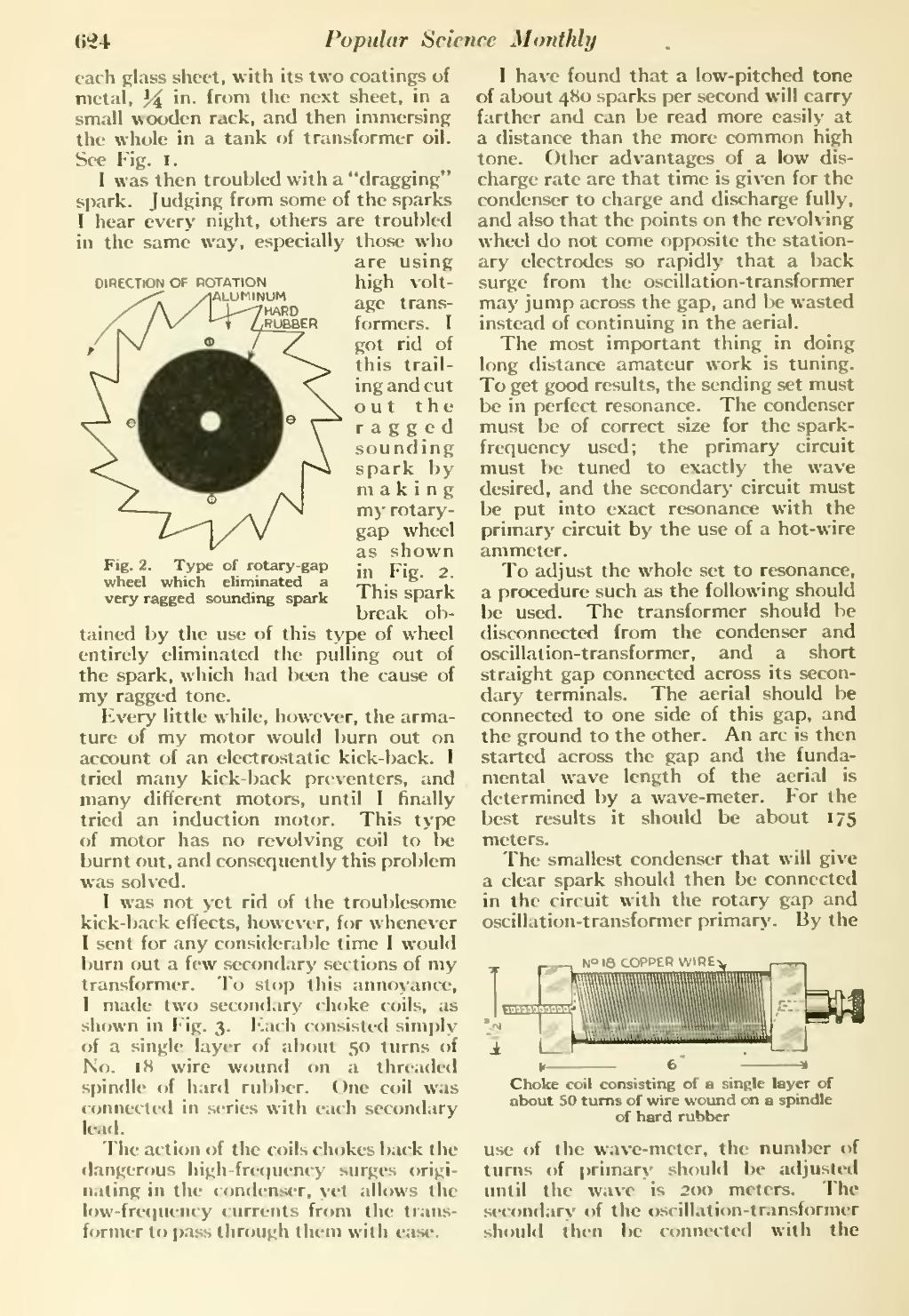624
��Popular Science Monthly
���Fig. 2. Type of rotary-gap wheel which eliminated a very ragged sounding spark
��each glass sheet, with its two coatings of metal, i4 '"• from the next sheet, in a small wooden ruck, and then immersing the whole in a tank of transformer oil. See Fig. i.
I was then troubled with a "dragging" spark. Judging from some of the sparks I hear every night, others are troubled in the same way, especially those who
are using
DIRECTION OF ROTATION high Volt-
JMiNUM trans-
7HAR0 fSe trans
/RUBBER formers. I got rid of this trail- ing and cut out the ragged sounding spark by making my rotary- gap wheel as shown in Fig. 2. This spark break ob- tained by the use of this type of wheel entirely eliminated the pulhng out of the spark, which had been the cause of my ragged tone.
Every little while, however, the arma- ture of my motor would burn out on account of an electrostatic kick-back. I tried many kick-back preventers, and many different motors, until I finally tried an induction motor. This type of motor has no revolving coil to be burnt out, and consequently this problem was soU'ed.
I was not yet rid of the troublesome kick-back effects, however, for whenever I sent for any considerable time I would burn out a few scconchiry sections of my transformer. To stop this annoyance, 1 made two secondary choke coils, as shown in I'"ig. 3. ICach consisted simply of a single layer of about 50 turns of No. 18 wire wound on a threaded si)in{llc of hard rubber. One coil was comH-ctcd in scries with each secondary lead.
The aclicjn of the coils chokes back the dangerous high -free] ucncy surges origi- nating in the condenser, yet allows the !ow-fre(]ui-ncy currents from the trans- former to pass through them with ea.sc.
��I have found that a low-pitched tone of about 4H0 sparks per second will carry farther and can be read more easily at a distance than the more common high tone. Other advantages of a low dis- charge rale are that time is given for the condenser to charge and discharge fully, and also that the points on the re\olving wheel do not come opposite the station- ary electrodes so rapidly that a back surge from the oscillation-transformer may jump across the gap, and be wasted instead of continuing in the aerial.
The most important thing in doing long distance amateur work is tuning. To get good results, the sending set must be in perfect resonance. The condenser must be of correct size for the spark- frequency used; the primary circuit must be tuned to exactly the wave desired, and the secondary- circuit must be put into exact resonance with the primary circuit by the use of a hot-wire ammeter.
To adjust the whole set to resonance, a procedure such as the following should be used. The transformer should be disconnected from the condenser and oscillation-transformer, and a short straight gap connected across its secon- dary terminals. The aerial should be connected to one side of this gap, and the ground to the other. An arc is then started across the gap and the funda- mental wave length of the aerial is determined by a wave-meter. For the best results it should be about 175 meters.
The smallest condenser that will give a clear spark should then be connected in the circuit with the rotary gap and oscillation-transformer primary. By the
��N°18 COPPER WIRE
���Choke coil consisting of a sinRic layer of
about 50 turns of wire wound on a spindle
of hard rubber
use of the wave-meter, the number i>f turns of primary should be adjusted until the wave is 200 meters. The secondary of the oscillation-transformer should then be connocted with the
�� �
